Introducción
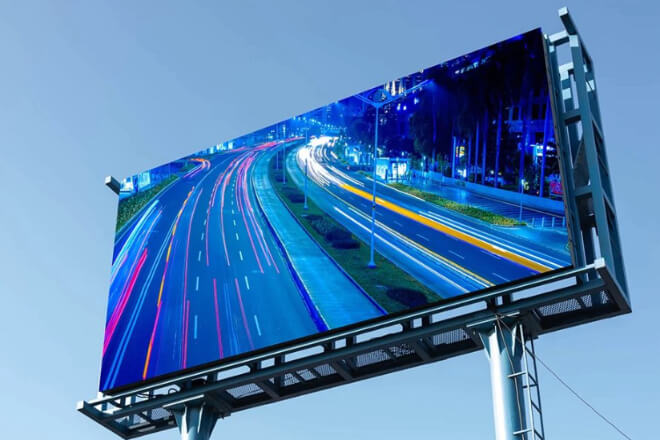
Whether it is a commercial display or a professional field, choosing a suitable display is crucial. But facing the dazzling array of products on the market.
Are you still hesitating: How big is the difference between an HD Pantalla LED and an ordinary screen? Today, let’s explore this issue in depth and provide you with a comprehensive guide.
Tabla de contenido
Difference 1: Resolution and image quality
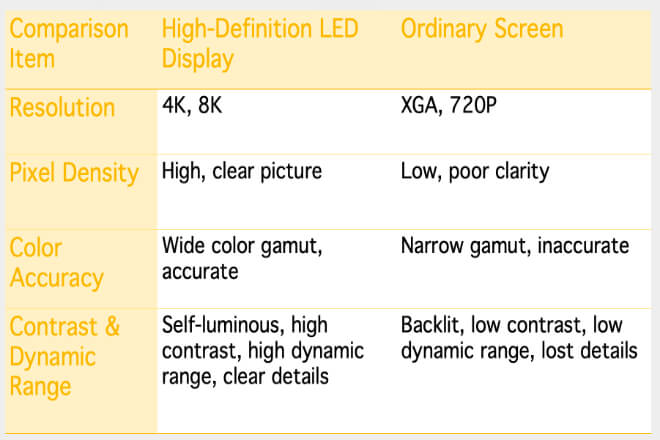
1). Comparison of resolución
The resolution of the HD LED display is amazing. 4K has 3840×2160 pixels, and 8K is even more powerful, reaching 7680×4320 pixels.
The calculation of pixel density is not complicated. It is to divide the total number of pixels by the screen area. The unit is PPI (pixels per inch).
For example, a 4K HD LED display with a screen diagonal of 55 inches has a much higher pixel density than an ordinary screen, and the picture is naturally more delicate. The common resolution of ordinary screens is far worse.
For example, 1024×768 pixels (XGA) and 1280×720 pixels (720P) have a small total number of pixels, and the clarity is far behind that of high-definition LED displays.
When viewing high-definition photos, complex patterns, or text, the image edges of high-definition LED displays are very clear, while ordinary screens may be blurred or even jagged.
2). Color reproduction
The color performance of high-definition LED displays is amazing, with a wide color gamut that can reach or even exceed 100% of the NTSC color gamut standard.
This means that it can accurately present various colors, such as bright red, emerald green, and deep blue.
For example, when looking at natural scenery pictures, high-definition LED displays can restore the blue sky.
The green grass, and the bright colors of flowers to the same as the real ones, and the pictures are particularly realistic.
Ordinary screens are not so powerful, with a very narrow color gamut, generally only reaching about 70% of the NTSC color gamut standard.
This will lead to color deviation. For example, when displaying bright colors, red may become darker or pink, and green may become yellowish.
The color of the original image cannot be restored at all, which makes it uncomfortable to watch.
3). Contrast and dynamic range
A big advantage of high-definition LED displays is that they can emit light by themselves, and each pixel can emit light and adjust the brightness independently.
This gives it an ultra-high contrast ratio. Contrast refers to the brightness ratio of the brightest and darkest parts of the screen.
The contrast ratio of high-definition LED displays can reach tens of thousands to one or even higher.
When displaying high dynamic range images, such as urban landscapes at night, a high-definition LED display can clearly show the details between bright lights and dark skies, and the picture is full of layering.
Ordinary screens are different. For example, LCD screens require backlight sources and have very low contrast ratios, generally only about 1000 to 1.
When displaying high dynamic range images, the contrast and dynamic range are not enough.
Ordinary screens may overexpose bright parts and lose details in dark parts, so the picture does not look so layered, affecting the viewing experience.
Difference 2: Power consumption and energy efficiency
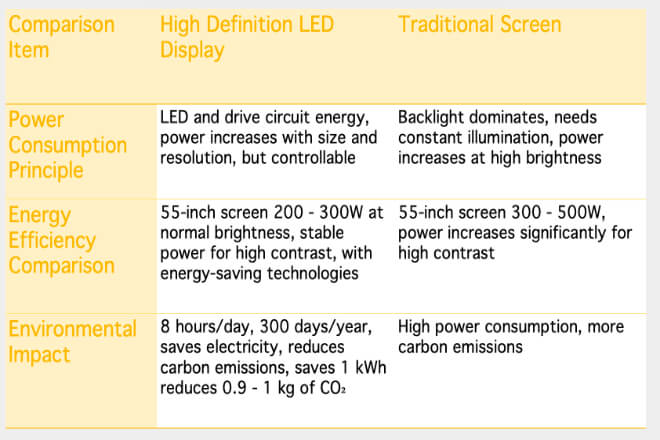
1). Analysis of the el consumo de energía principle
The power consumption of high-definition LED display screens mainly comes from the light emission of LED lamp beads and the energy consumption of the driving circuit.
LED lamp beads themselves are energy-saving, but when the screen size increases and the resolution increases, the number of lamp beads increases, and the power consumption will also increase accordingly.
However, due to the high efficiency of LED, the overall energy consumption is relatively controllable.
For ordinary screens, especially LCD screens, the backlight source accounts for a large proportion of their power consumption.
The backlight source needs to emit light continuously to illuminate the screen, which makes the power consumption of ordinary screens relatively high.
Especially when displayed at high brightness, the energy consumption of the backlight source will increase further.
2). Energy efficiency comparison
In actual use, the power consumption difference between high-definition LED display screens and ordinary screens is obvious.
Taking the common 55-inch screen as an example, at normal brightness, the power consumption of high-definition LED display screens is about 200-300 watts.
The power consumption of ordinary LCD screens may reach 300-500 watts. When displaying high-contrast content.
The power consumption of high-definition LED display screens does not change much due to their self-luminous characteristics.
While the backlight source of ordinary screens needs to be brighter, and the power consumption will increase significantly.
HD LED displays also have many applications in energy-saving technology, such as smart dimming, which can automatically adjust the screen brightness according to the ambient light.
Regional backlight control can only light up the required area according to the display content. These technologies can effectively reduce power consumption.
3). Impact on the environment
From the perspective of long-term use, the difference in energy consumption between HD LED displays and ordinary screens cannot be ignored.
Assuming that a screen is used for 8 hours a day and 300 days a year, HD LED displays can save hundreds of kilowatt-hours of electricity per year compared to ordinary screens.
This not only reduces electricity bills, but more importantly, it reduces carbon emissions. According to estimates, every kilowatt-hour of electricity saved can reduce carbon dioxide emissions by about 0.9-1 kg.
Therefore, HD LED displays have obvious advantages in environmental protection, help reduce carbon footprints, and have a positive impact on the environmental.
Difference 3: Service life and reliability
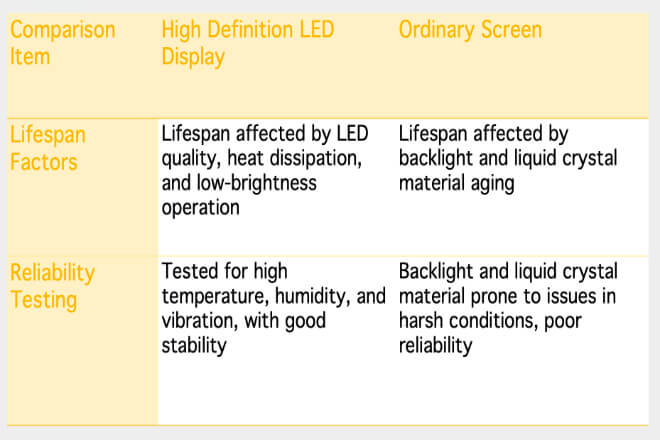
1). Lifespan factors of LED displays
The lifespan of HD LED displays mainly depends on LED lamp beads. Good quality lamp beads can maintain good brightness after five or six years.
However, if the temperature is high and the current is large, the lamp beads are easy to break. For every 10℃ rise in temperature, the lifespan may be reduced by 30%.
Therefore, heat dissipation is very important. If the heat dissipation is good, the display screen can be used for a long time.
For example, a good heat dissipation design can keep the display screen stable even in a high-temperature environment.
Moreover, when the lamp beads of the high-definition LED display screen work at low brightness.
The power consumption is lower and the heat is less, which also helps to extend the lifespan.
2). Lifespan limit of ordinary screens
Ordinary screens (such as LCD) are not so durable. The backlight source is the key to the LCD screen. Over time, the backlight brightness will dim, and the screen will look dark.
It is also easy to leak light after a long time of use, and the screen display will be uneven. The color will also fade, and the original bright pictures will not look so beautiful.
Moreover, the liquid crystal material of the ordinary screen will also age, resulting in a decrease in picture quality.
For example, after the liquid crystal material ages, the response speed will slow down, and the screen will have a smear.
These problems not only affect the visual effect, but may also shorten the lifespan of the screen.
3). Reliability test and comparison
High-definition LED displays must undergo high temperature, high humidity, vibration.
And other tests before leaving the factory to ensure stable operation in various environments. In contrast, ordinary screens do not perform as well under these test conditions.
In high-temperature and high-humidity environments, the backlight and liquid crystal materials of ordinary screens are more likely to have problems.
For example, the backlight may age prematurely, and the performance of the liquid crystal material will also decline.
This makes ordinary screens more prone to failures during long-term use, such as screen flickering and color distortion.
Therefore, high-definition LED displays are more reliable and safer to use.
Difference 4: Application scenarios and adaptability
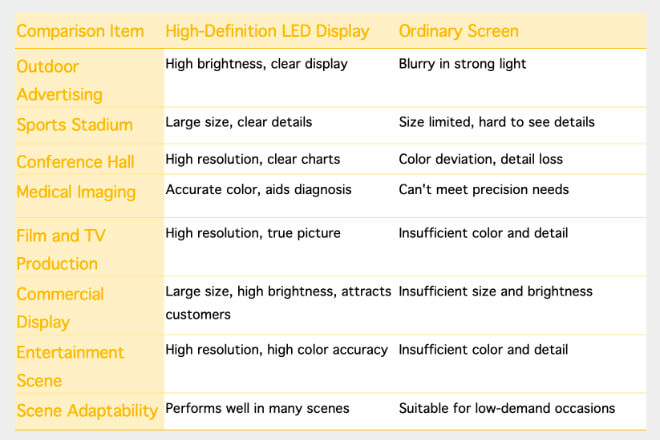
1). Applicable scenarios of high-definition LED displays
High-definition LED displays can be used in many places. For example, on outdoor billboards, its high-brillo screen can clearly display advertising content even under the sun, attracting the attention of passers-by.
In sports estadios, large-sized high-definition LED displays allow spectators to clearly see every detail of the game, such as the expressions and movements of the players, no matter where they sit.
In high-end conference halls, the high resolution and color accuracy of high-definition LED displays can make complex charts and data look clear, making the meeting content more intuitive and easy to understand.
In professional fields, high-definition LED displays also perform well. In terms of medical imaging, doctors need precise colors and details to assist in diagnosis.
HD LED displays can meet this demand, allowing doctors to see the condition more accurately.
In film and television post-production, high resolución and color accuracy are crucial to ensuring picture quality. HD LED displays allow production staff to see the most realistic picture effects.
2). Application limitations of ordinary screens
Ordinary screens are a bit powerless in some places where high display effects are required.
For example, in a strong light environment, the display effect of ordinary screens will become blurred, and the details of the picture will be difficult to see clearly.
In terms of size, it is difficult for ordinary screens to be as large as HD LED displays, which limits their application in large venues.
Moreover, ordinary screens may have color deviation or loss of details when displaying high-resolution content, which is a big problem for scenes that require precise display.
3). Comparison of scene adaptability
Specifically, the performance differences between HD LED displays and ordinary screens in different application scenarios are obvious.
In commercial displays, the large size and high brightness of HD LED displays can attract customers’ attention, display high-quality product pictures and videos, and enhance brand image.
Ordinary screens may not achieve the same effect in commercial displays due to insufficient size and brightness.
In entertainment scenarios, the high resolution and color accuracy of high-definition LED displays can provide a more realistic viewing experience, especially when watching high-definition movies and playing games.
In contrast, ordinary screens may affect the viewing experience due to insufficient color and details.
In general, high-definition LED displays can perform well in a variety of application scenarios, while ordinary screens are more suitable for some occasions where display effects are not so demanding.
Diferencia 5: Costo y rendimiento de costos
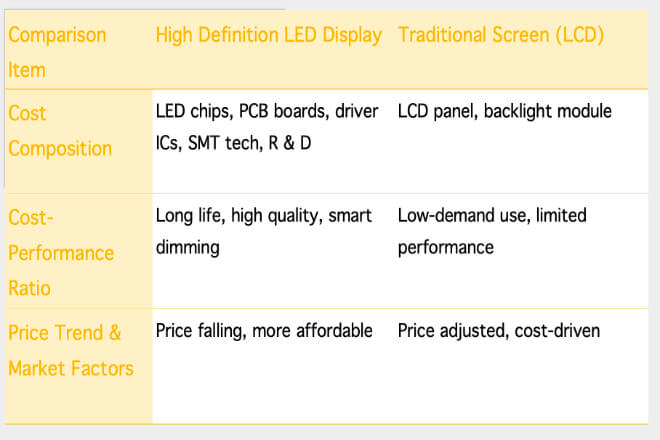
1) Análisis de la estructura de costos
The cost of high-definition LED displays is mainly composed of several parts. First of all, raw materials, LED lamp beads, are key components, and the cost accounts for about half.
For example, for small-pitch LED displays, lamp beads cost more. There are also PCB boards, driver ICs, etc., which add up to a lot.
The manufacturing process is also very important. For example, using advanced SMT patch technology, although the quality is good, the cost will also increase.
R&D expenses cannot be ignored, including the salary of the R&D team, patent fees, etc.
The cost structure of ordinary screens is not the same. LCD panels are the biggest part, accounting for about 60%, and backlight modules account for 20%.
In terms of raw material procurement, the cost of LCD panels and backlight modules for ordinary screens is relatively stable.
However, the price of LED lamp beads for high-definition LED displays fluctuates greatly.
In terms of production technology, the manufacturing technology of ordinary screens is relatively mature, and cost control is relatively stable.
2). Evaluación de rentabilidad
From the perspective of service life, high-definition LED displays have a long life and low maintenance costs, making them more cost-effective in the long run.
In terms of display effect, the high brightness, high contrast, and color accuracy of high-definition LED displays give them more advantages in professional fields, such as medical imaging and film and television post-production.
In terms of power consumption, although the power consumption of high-definition LED displays is high, energy consumption can be reduced through technologies such as intelligent dimming.
Ordinary screens are relatively cost-effective in some places where display effects are not required, such as ordinary home TVs, small conference rooms, etc.
However, in strong light environments, the display effect of ordinary screens is not good, and there are also restrictions on size and display content.
In different application scenarios, it is important to choose a display screen according to needs.
For example, in commercial displays, the large size and high brightness of high-definition LED displays can attract customers and enhance brand image.
While in home entertainment scenarios, ordinary screens may be more suitable for users with limited budgets.
3). Price trends and market factors
The price of high-definition LED displays is slowly declining with the development of technology and the expansion of the market scale.
Technological progress has reduced the cost of raw materials such as LED chips and improved production efficiency.
So the price of high-definition LED displays is becoming more and more affordable.
In the market competition, the price of ordinary screens is also adjusted by optimizing production processes and reducing costs. The price difference between the two has a great impact on consumer choices.
In high-end applications, the high cost-performance of high-definition LED displays makes it more competitive, while in ordinary applications, the price advantage of ordinary screens may attract more consumers.
6. Conclusión
Through the above comparison, I believe you have a clearer understanding of the difference between high-definition LED displays and ordinary screens.
Whether you are a high-end user pursuing the ultimate visual experience or an ordinary consumer who pays attention to cost performance, you can find the most suitable display for yourself.
Finalmente, si quieres saber más sobre las pantallas LED, Por favor póngase en contacto con nosotros.
